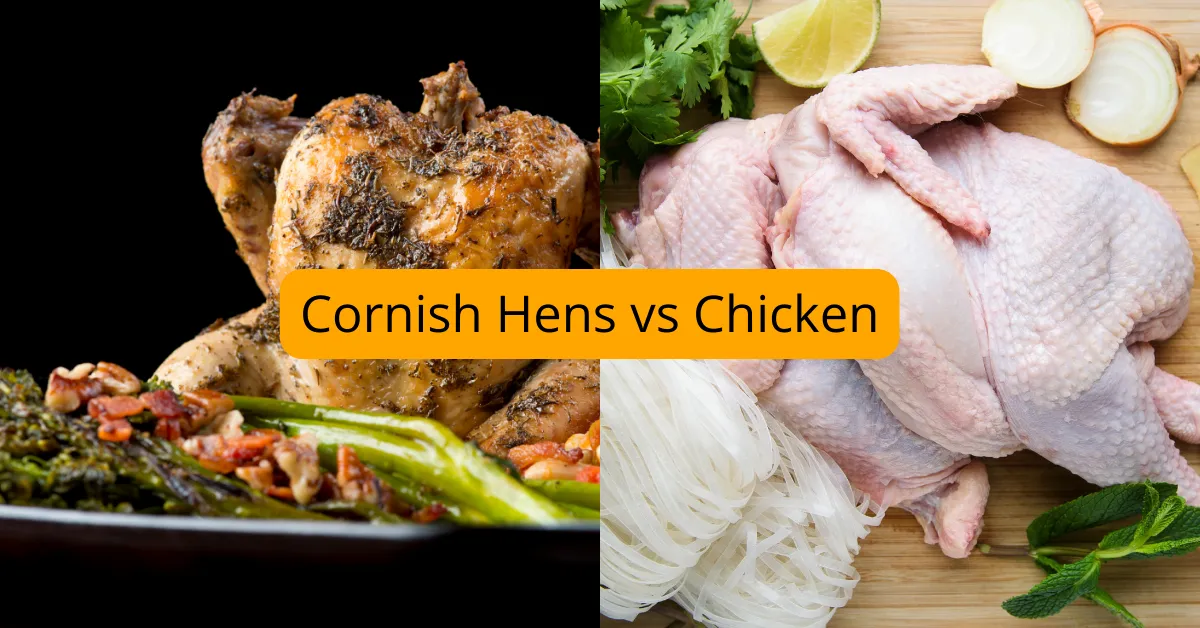Are Cornish hens as good as chicken? If you are someone who loves poultry, you may have wondered about the differences between Cornish hens and chickens. While both are birds, they have some notable differences in terms of size, taste, and nutritional value. In this article, we will explore the differences between Cornish hens and chickens and help you decide which one is the best choice for your next meal.
Understanding Cornish Hens and Chickens: Cornish hens are small chickens that weigh around 1-2 pounds and are usually four to five weeks old. In comparison, a regular chicken is much larger and weighs around 4-8 pounds and is usually eaten at around 8-20 weeks of age. Cornish hens have a delicate texture and a subtle flavor, while chickens have a stronger, more pronounced taste.
Nutritional Comparison: When it comes to nutrition, Cornish hens are a better choice if you are watching your calorie intake. They are comprised of primarily white meat and are very lean, making them an excellent source of protein. In contrast, chickens have a higher fat content and are a good source of vitamins and minerals, such as iron and zinc.
Key Takeaways
- Cornish hens are small chickens that have a delicate texture and subtle flavor, while chickens have a stronger taste.
- Cornish hens are a better choice if you are watching your calorie intake, while chickens are a good source of vitamins and minerals.
- Both Cornish hens and chickens have their own unique culinary uses and are widely available in most grocery stores.
Understanding Cornish Hens and Chickens
Cornish Hens
Cornish hens are a type of chicken that are smaller in size and weight compared to regular chickens. They are typically harvested when they are one to two pounds, while whole roaster chickens can weigh between three to seven pounds when sold. Cornish hens are known for their tender, flavorful meat and are often used in special occasion meals or as a substitute for larger chickens in recipes. They are sometimes referred to as “game hens,” but this is a misnomer as they are not game birds. Here’s The Ultimate Cornish Hen Recipe Guide: From Prep to Plate to enjoy Cornish Hens.
Chickens

Chickens are domesticated birds that are raised for their meat, eggs, and feathers. There are many different breeds of chickens, each with their own unique characteristics and uses. Some breeds are raised primarily for their meat, while others are raised for their eggs. Chickens are typically sold whole, either fresh or frozen, and can be found in most grocery stores and butcher shops.
When it comes to cooking and eating, there are some differences between Cornish hens and chickens. Because Cornish hens are smaller, they cook faster than regular chickens and are often cooked whole. They are also often stuffed with herbs and other seasonings to infuse flavor into the meat. Chickens, on the other hand, are usually cut into pieces before cooking, such as chicken breasts, thighs, and wings.
In terms of taste and texture, Cornish hens are known for their tender, juicy meat and slightly gamey flavor. Some people prefer the taste of Cornish hens over chicken, while others find them to be too small and not as flavorful as regular chickens. Chickens, on the other hand, have a meatier texture and a more pronounced flavor that can vary depending on the breed and how they are raised.
Overall, whether you prefer Cornish hens or chickens comes down to personal preference and how you plan on cooking them. Both are delicious and versatile ingredients that can be used in a variety of recipes.
Are Cornish Hens As Good As Chicken?
When it comes to comparing Cornish hens and chicken, it’s important to consider their nutritional value. Here’s a breakdown of the nutritional content of both:
Calorie Comparison
Cornish hens are smaller than chickens, so it’s no surprise that they have fewer calories. A 4-ounce serving of Cornish hen provides about 200 calories, while a 4-ounce serving of chicken provides about 300 calories. However, the calorie count can vary depending on the cooking method and any added ingredients, such as marinades or sauces.
Protein Content
Both Cornish hens and chicken are excellent sources of protein. A 4-ounce serving of Cornish hen provides about 19 grams of protein, while a 4-ounce serving of chicken provides about 21 grams of protein. Protein is essential for building and repairing muscles, and it’s important for overall health.
Fat Content
Cornish hens are slightly leaner than chickens due to their young age and small size. A 4-ounce serving of Cornish hen provides about 14 grams of fat, while a 4-ounce serving of chicken provides about 18 grams of fat. However, the fat content can vary depending on the cooking method and any added ingredients.
Vitamin and Mineral Comparison
Both Cornish hens and chicken are good sources of vitamins and minerals. They both contain important nutrients like niacin, phosphorus, and selenium. However, Cornish hens are slightly higher in niacin, while chicken is slightly higher in phosphorus and selenium. It’s important to note that the nutrient content can vary depending on the diet and living conditions of the birds.
Overall, both Cornish hens and chicken can be part of a healthy diet. When it comes to choosing between the two, it really comes down to personal preference and cooking method.
Culinary Uses
When it comes to culinary uses, both Cornish hens and chickens are versatile ingredients that can be used in a variety of dishes. Here are some of the most common ways that Cornish hens and chickens are used in cuisine:
Cornish Hens in Cuisine
Cornish hens are often used in dishes that require smaller portions, such as individual servings or appetizers. Because of their smaller size, they cook faster than chickens and are a great option for those who want to prepare a quick and easy meal. They are also a popular choice for special occasions and holiday meals, as they make an impressive presentation when served whole.
Here are some common ways to prepare Cornish hens:
- Roasted: Roasting Cornish hens is a popular way to prepare them. They can be seasoned with herbs and spices and stuffed with aromatics, such as garlic and lemon, for added flavor.
- Grilled: Grilling Cornish hens is another popular method of preparation. They can be marinated in a variety of sauces and spices before grilling to add flavor.
- Braised: Braising Cornish hens involves cooking them slowly in a liquid, such as broth or wine. This method of preparation results in a tender and flavorful dish.
Chickens in Cuisine
Chickens are a staple ingredient in many cuisines around the world. They are a versatile ingredient that can be used in a variety of dishes, from soups and stews to casseroles and curries. Chicken is also a popular choice for grilling and roasting.
Here are some common ways to prepare chicken:
- Roasted: Roasting a whole chicken is a classic way to prepare it. It can be seasoned with herbs and spices and stuffed with aromatics, such as onions and garlic, for added flavor.
- Grilled: Grilled chicken is a popular option for those who want a healthier alternative to fried chicken. It can be marinated in a variety of sauces and spices before grilling to add flavor.
- Fried: Fried chicken is a popular comfort food that is often served with sides such as mashed potatoes and coleslaw. It can be seasoned with a variety of spices and herbs before frying to add flavor.
In conclusion, both Cornish hens and chickens have their own unique culinary uses and can be used in a variety of dishes. Whether you prefer the smaller size and tenderness of Cornish hens or the versatility of chickens, both are great options for home cooks and professional chefs alike.
Cost and Availability
When it comes to deciding between Cornish hens and chickens, cost and availability are important factors to consider. Here is a breakdown of the price and market availability of both poultry options.
Price of Cornish Hens
Cornish hens are generally more expensive than regular chickens due to their smaller size and higher demand. On average, you can expect to pay anywhere from $2.50 to $5 per pound for Cornish hens, depending on the size and current promotions. The price shown will be for an average size range of 1.75-2 pounds each. However, prices may vary depending on where you live and how far the nearby store is.
Price of Chickens
In comparison to Cornish hens, chickens are generally more affordable and readily available. On average, you can expect to pay around $1.50 to $3 per pound for chickens, depending on the size and current promotions. The price shown will be for an average size range of 3-5 pounds each. However, prices may vary depending on where you live and how far the nearby store is.
Market Availability
Cornish hens are not as widely available as chickens, but they can still be found at most grocery stores and specialty markets. They are typically sold frozen and pre-packaged, which can make them more convenient for smaller households. Chickens, on the other hand, are widely available and can be found fresh or frozen in most grocery stores.
When it comes to choosing between Cornish hens and chickens, it ultimately comes down to personal preference and budget. While Cornish hens may be more expensive, they can be a great option for smaller households or special occasions. Chickens, on the other hand, are a more affordable and versatile option that can be used for a variety of meals.
FAQs
Which is better Cornish hen or chicken? Cornish hens are smaller and tender, offering a delicate flavor. Chickens are larger and versatile in dishes. Preference depends on the desired serving size and taste.
What is the difference between Cornish hen and chicken? Cornish hens are a specific breed of chicken, smaller in size, typically weighing less than 2 lbs. Regular chickens are larger and can vary in breed.
Can you substitute Cornish hens for chicken? Yes, Cornish hens can be substituted for chicken. Adjust cooking times due to size differences. One hen serves 1-2 people, while a chicken serves more.
What is the point of Cornish hen? Cornish hens provide individual servings, making them ideal for elegant dinners. Their tender meat and presentation value are appreciated in gourmet settings.
Is Cornish hen better than turkey? Cornish hen is tender and serves 1-2 people, while turkey is larger and ideal for big gatherings. Preference depends on the occasion and number of guests.
What is the best form of chicken to eat? Grilled or baked chicken breasts are among the healthiest forms due to low fat and high protein. However, the best form varies based on dietary preferences and recipes.
Conclusion
In summary, Cornish hens and chicken are both great options for meals. The biggest difference between the two is how they are served. Cornish hens are smaller and can make an appealing dinner presentation when prepared as an individual entrée. On the other hand, chicken is more versatile and can be used in a variety of dishes.
When it comes to taste, Cornish hens are more tender than regular chicken, according to the United States Department of Agriculture. This is because Cornish hens are younger and have a shorter lifespan before they are harvested. However, taste is subjective and some people may prefer the taste of chicken over Cornish hens.
In terms of nutrition, both Cornish hens and chicken are good sources of protein. Cornish hens are slightly higher in fat and cholesterol than chicken, but they are also smaller, so the difference in nutrition may not be significant.
Ultimately, the choice between Cornish hens and chicken depends on personal preference and the specific dish being prepared. Both can be delicious and nutritious options for meals.









